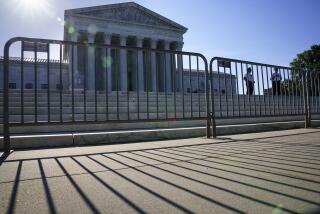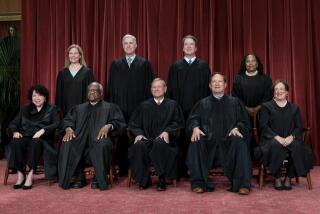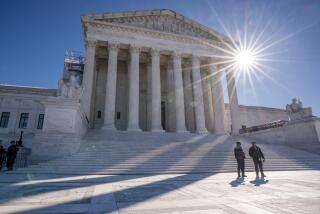Blind Faith
- Share via
The Supreme Court of the United States lends itself easily to the metaphor of a church. Its building, perched atop Washington, D.C.’s Capitol Hill, is fashioned after a Greek temple. Its courtroom, adorned with marble columns and rich velvet drapery, is arranged with a raised dais from which the justices (the judiciary’s high priests) preside and plain wooden pews for the parishioners (lawyers and laypersons) attending its functions. Emerging from the building’s private cloisters, the justices don black vestments to perform their public duties, and they interpret the Constitution--our political commandments--in opinions laced with prophetic judgments condemning the apostasies of other sectors of government.
In “Keeping the Faith,” John E. Semonche, a history professor at the University of North Carolina, Chapel Hill, has taken this metaphor and made it the organizing principle of the court’s entire history. In Semonche’s view, throughout its 200-year existence, the court has served as the fashioner and keeper of our “civil religion,” which he describes as a moral creed emanating from the Declaration of Independence and the Constitution that places paramount importance on national unity and the protection of individual rights. Rather than serving as referees or neutral arbiters of our society’s legal conflicts, the justices, Semonche argues, have been (and should be) “committed players,” evangelists promoting the cohesion of the national community by recognizing the equality, liberty and fundamental “dignity” of every individual. Indeed, “Keeping the Faith” is a celebration both of these values and the court’s role in nurturing them.
In Semonche’s account, three tenets of our national scripture are of greatest significance. First is the Declaration of Independence’s affirmation of the self-evident truth that “all men are created equal” and are “endowed by their Creator with certain inalienable Rights.” Second is the Constitution’s preamble, which identifies the document as the creation not of separate states or of elected representatives but of the people. “We the people,” he reminds us of its opening lines, “of the United States in order to form a more perfect Union. . . .” And third, not surprisingly, is the Bill of Rights, with its specific guarantees of individual liberty.
These documents, according to Semonche, formed a distinctly American creed from which the Supreme Court emerged, gradually but persistently, as the main protector and expositor. From the outset, he claims, the justices of the Supreme Court viewed national cohesion (as opposed to states’ rights) as a “precondition for the protection of individual rights” and saw their ultimate responsibility “as safeguarding these rights.” In so doing, they have served, he claims, as our “national conscience” and a “significant unifying force within [our] pluralistic society,” educating “the people as to their responsibilities under the civic faith.”
Tracing the court’s trajectory from origins so humble that George Washington had difficulty rounding up a first chief justice through its current ascendancy as the final arbiter of our laws, Semonche describes the court’s history as a sometimes halting but always inevitable ascension toward the nationalist, civil libertarian ideals he places at the heart of our civil religion. In the process, he cloaks all the favorite legal principles of contemporary liberals--such as affirmative action, abortion rights, the rigorous separation of church and state and a broad view of freedom of speech--with the vestments of quasi-religious justification. And Semonche builds his case for the court’s progressive march toward liberalism impressively, deploying not only the familiar landmark cases of constitutional law--such as Marbury vs. Madison and Brown vs. Board of Education--but also lesser known cases in fields ranging from the court’s treatment of the fugitive slave laws before the Civil War to its attitude toward McCarthyism in the middle of this century.
Despite its considerable scholarship, “Keeping the Faith” is ultimately unconvincing. In historical terms, it is certainly true, as Semonche claims, that the court has served at times as a guardian of national unity, equality and individual liberty. Early on, under Chief Justice John Marshall, it established not only its own authority to declare unconstitutional the acts of elected legislatures but also the supremacy of federal laws and interests over those of the states. And, more recently, under Chief Justice Earl Warren, the court dramatically expanded the power of the federal government vis-a-vis the states, broadened civil liberties and, in Brown vs. Board of Education and after, breathed new life into the constitutional promise of equality.
But other periods of the court’s history--and the nation’s--fit far less neatly into Semonche’s thesis. While Semonche finds a strong American commitment to equality from the founding moment of the Declaration of Independence, that commitment is hard to reconcile with the original Constitution’s tolerant view of slavery and the failure of the original Bill of Rights even to mention the word. As Garry Wills and others have argued persuasively, the concept of equality as a paramount American concern came only belatedly, at the cost of civil war, and through the scriptural revisions of Lincoln and the Reconstruction Republicans.
In the theater of law, while Semonche properly emphasizes the unifying nationalism of the court under Marshall, that commitment disintegrated over the issue of slavery. This dissolution occurred most notoriously in the Dred Scott case in which Marshall’s successor, Roger Taney, dismissed the human rights of slaves and denied the federal government’s power to outlaw slavery in the territories. Although Semonche acknowledges that the Dred Scott decision--which helped usher in the Civil War--undermined the court’s “priestly role,” he presents it largely as an aberration in the court’s commitment to national unity.
The court’s post-Civil War decisions, however, cast considerable doubt on that assessment. After the war, the nation added new articles of faith to its sacred text: the 13th, 14th and 15th Amendments, banning slavery, establishing the principle of racial equality and requiring the states to respect due process, the “privileges and immunities” and the voting rights of all the nation’s citizens. Yet the Supreme Court, for the better part of a century, vested these potentially transformative new commandments with little meaning. Starting shortly after the war, the justices read the due process and privileges and immunities clauses as protecting only property rights (not personal liberties) against state intrusion and, in the crucial area of race, fashioned the legal fiction of “separate but equal” as an end run around the 14th Amendment’s guarantee of “equal protection of the laws.”
Later still, the reactionary court of the 1930s tried mightily to stifle Roosevelt’s New Deal by declaring unconstitutional many of his progressive economic reforms. And the current court--reinvigorating state’s rights and retrenching in most areas of civil rights and civil liberties--further confounds Semonche’s thesis. And, thus, for long periods, Semonche must build his case for the court’s role not on its majority opinions but on the dissents of often lonely Jeremiahs--John Marshall Harlan decrying the doctrine of separate but equal, Louis Brandeis championing freedom of speech amid the Red Scare of the 1920s or William Brennan inveighing against the death penalty and proclaiming the “constitutional ideal of human dignity.”
The problem here is more than one of historical perspective. Semonche celebrates the idea of the Supreme Court having nearly exclusive responsibility for safeguarding our civil religion in large part because he considers it somehow inevitable that the court, in the run of things, will wield its “religious authority” in favor of greater personal freedom and “to promote unity in a pluralistic society.” For those with a more equivocal view of the court’s historical tendencies, even those inclined to agree with Semonche’s unabashed liberalism, his court worshiping appears a dangerous blind faith.
The nation must be appropriately thankful for the court’s many contributions, especially its repudiation of Jim Crow from the schoolhouse to the ballot box, its protection of free expression and its commitment, albeit belated, to requiring the states to observe the liberties safeguarded in the Bill of Rights. But there are terrible pitfalls in an excessive reliance on the court, even apart from its erratic record. There is an inherent tension between surrendering to nine life-tenured, non-elected justices’ ultimate responsibility for our civil religion and basic notions of democratic governance. While there can be no disputing Semonche’s observation that the justices inevitably exercise moral judgment in deciding the cases that come before them, they are not freewheeling arbiters of our political and moral culture or, as the renowned Judge Learned Hand put it many years ago, the justices do not serve as our “Platonic Guardians.”
The elected branches of government have a responsibility to our civil religion--our constitutional tradition--as well. And the more we look solely to the court for our spiritual guidance, the more we accept (as Semonche does) its performing “as much a moral role as a legal one” and the less we will expect and demand from those we elect to govern us and the more they, in turn, will abdicate to the court. Every day it seems, on this score, we are reminded how far atrophied are the muscles of constitutional judgment within the elected branches. Perhaps we would be fortunate if Semonche were right and the court alone could save us from this wasting. But it never has, and cannot now.
More to Read
The biggest entertainment stories
Get our big stories about Hollywood, film, television, music, arts, culture and more right in your inbox as soon as they publish.
You may occasionally receive promotional content from the Los Angeles Times.










